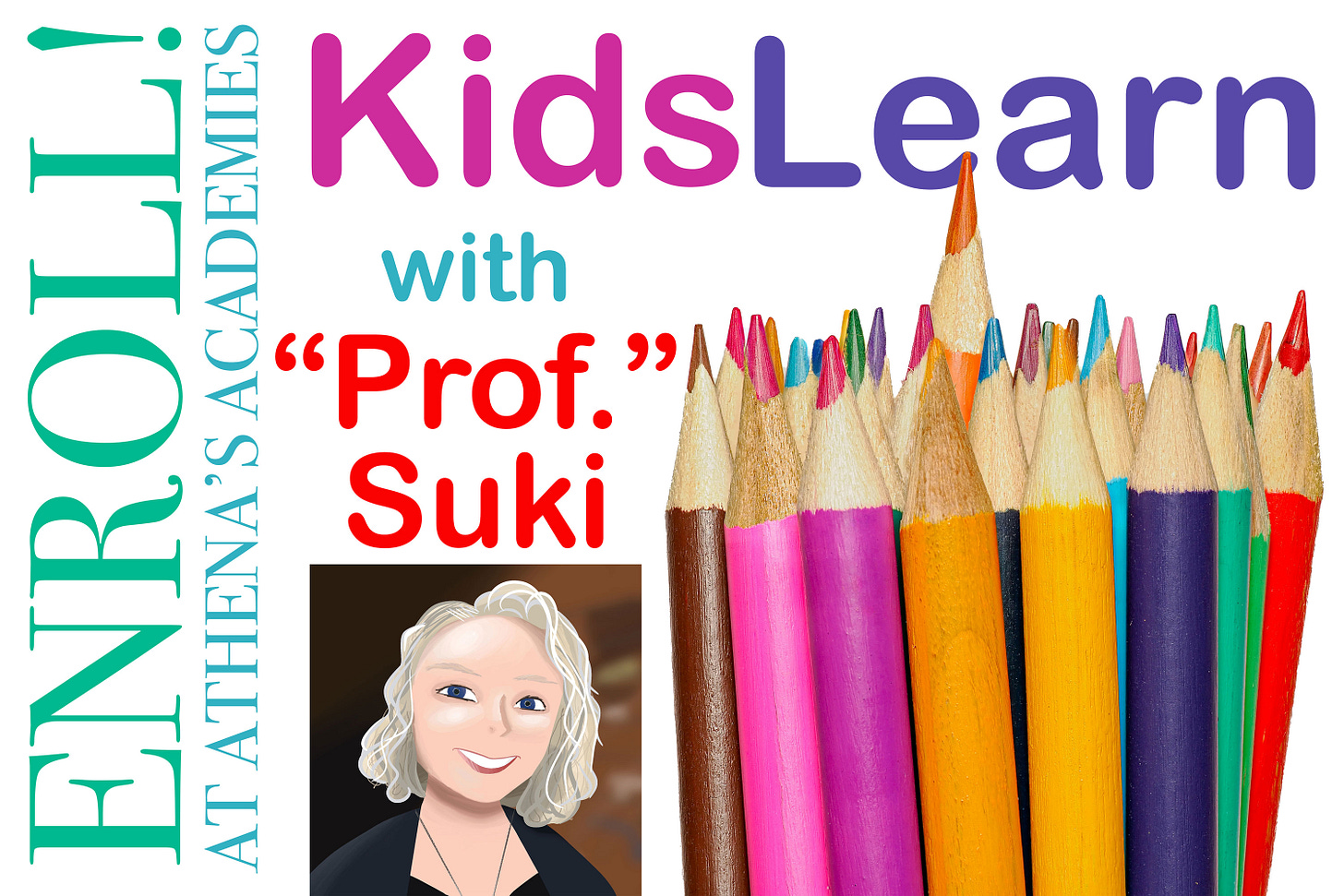I’ve always been interested in what data can tell us about ourselves. At the same, time, I could bore you endlessly about which data doesn’t fit my personal experience. Those two points of reference, my belief that compiling data on humanity is important, and that data can be almost meaningless to a specific person, aren’t in conflict. I often see data lovers rhapsodize about a forest “full of” tall trees while forgetting to look down at the exquisite fungus at their feet.
The KidsLearn Substack is written by Suki Wessling, known as “Prof.” Suki to her students. Scroll to the bottom for links to Suki’s work and more information. If you enjoy my work, please interact with this post. A “like” or comment goes a long way and will make my day!
Nowhere does this disconnect between data and experience rankle me more than in the conflict between education policy and on-the-ground education. I wholeheartedly support collecting data about student achievement and correlations with their education, but in a classroom, I expect a teacher to teach to the individual who, many times, just simply doesn’t align well within the data.
Case in point, phonics
New data shows that phonics is a far superior method to teaching large numbers of students to read.1 I don’t doubt the data. My public school experiences are limited to being a (very involved) mom, but I saw it in action there. Teachers were expected to inculcate the love of reading into all of their students, and that love of reading would then lead to their learning how to read without phonics. But that’s not how it works. Most kids—the data confirms this—need to be taught how to decipher a word.
Not my kids. Like many children with their general profile—high-achieving neurodivergent, two parents with advanced degrees, steeped in books from birth—they didn’t need phonics. In fact, I firmly believe that I delayed my older child’s reading by working with him on phonics; he entered first grade still pronouncing “the” as “tuh-HUH.” About six months after I gave up in frustration, he read his first book—Harry Potter. The data may be right, but it says nothing about that single child’s learning process.
My second child was lucky that I’d failed so miserably with the first. I never taught him phonics, never encouraged him to sound out words in books we were reading, and seemingly magically (though it’s not magic, it’s neurology in conjunction with family culture), he began to read well earlier than his older sibling.
Both of my children did have to learn phonics later, when they started to read books with unfamiliar words. But they never would have learned to read with phonics alone, because they have those brains that read by scanning whole words, brains that learn to read because they are simply fascinated with reading. If I had put my older one in a classroom that followed the data, he would have been labeled “a struggling reader.” But his Harry Potter-inspiring classroom was led by a wonderfully creative hippie teacher who hadn’t taught any phonics.
I put my younger child who was already reading in a Montessori kindergarten, and wasn’t surprised that the teacher reported that when she asked him to put blocks together to spell out “kuh-at-tuh,” he threw the blocks across the room. Montessori can be a wonderful approach, but under certain teachers, the curriculum can be overly didactic, leaning heavily on integrating outliers into the norm.
Thus, the block throwing. My kid never met a norm he didn’t throw blocks at.
Freddie read the data so I didn’t have to
I’ll admit that I’m not a fan of reading a educational studies in depth, but the provocative writer Freddie DeBoer did just that and packaged it up for our use. Now, I’m not saying that he didn’t put his bias into which studies he chose, but I agree with his overall argument, which is that we’re barking up the wrong tree when we try to design our schools around the idea that the numbers tell us how to educate children.
TL;DR
DeBoer looks at education data through the lens of relative performance vs. absolute performance: how students perform as measured against other student performance vs. how much a single student has learned. He shows that a focus on trying to legislate better educational outcomes for lower achieving students is bound to fail simply because any approach that benefits the lower achieving students (when we’re talking about large numbers, which is what a study usually does), will also benefit the higher achieving students. In other words, education policy often ignores the useful old adage “a rising tide lifts all boats.” If you find a better way to teach students, it will often help the highest achieving, also, so the lower achieving students’ position relative to the others can’t change.2
He points out that almost all celebrated studies that suggest changes to curriculum, teacher behavior, and classrooms show modest benefits at best, and those benefits were likely to come from schools that were so deficient that the change simply brought them to a low bar of proficiency. Finally, he argues that educational policy makers are unwilling to tackle the real causes of student underperformance because they’re hard and often not related to education. For example, he points out that improving air quality in poor and minority communities would offer an immediate cognitive benefit, but education policy is seen as separate from environmental policy. In summary, he writes:
Liberating ourselves from the false promise that schools alone can deliver social mobility allows us to build a healthier vision of both education and society. A strong social safety net ensures that those who are not destined for elite academic or professional success can still live with dignity and security. With those protections in place, we can let schools reclaim their true mission: nurturing intellectual curiosity for its own sake, encouraging students to pursue their interests in history, music, coding, or carpentry, and creating communities that teach empathy and civic responsibility.
In essence, what many of us have been saying over and over. Stop focusing on the numbers; pay attention to the children.
Some children left behind
My older child started formal education during the era of “No Child Left Behind” (Bush II), and they both moved through the system under “College for Everyone” (Obama). The idiocy at the core of NCLB has been well-documented:
“This system requires testing every student in math, reading and, soon, science and issuing sanctions to schools that do not show sufficient progress for each subpopulation of students toward an abstract goal of “100 percent proficiency” on state tests.”3
Clearly, its designers had failed math, because (from what I remember about math), it’s literally impossible to have 100% of any population over the 50th percentile.
Much as I appreciated the intentions behind C4E, it too was a failure—in this case, a failure of imagination. Not all people need or benefit from college. As my kids were coming up to high school, I was working as a parenting and education journalist. I spoke to teachers in our local schools who were seeing their much-needed technical education programs cut because they were no longer valued. A shop teacher told me that they’d cut him to half-time and his equipment budget to zero—in a city where the median household income was about 40% lower than the college town nearby. Those teens needed jobs, and the jobs they were likely to get required training programs, not college.
My kid never met a norm he didn’t throw blocks at.

Gather the numbers, but don’t live by the numbers
I am a fan of numbers because numbers tell us stories that our individual experiences might not tell us. The numbers in that working-class city where they cut funding for shop told me a story with a clear lesson: shop class was more important than college prep for many of those students.
But my time on the ground in education draws on my individual experiences, and there I learn another moral: the key to effective education is flexibility. In every high school with a large number of working class kids, you’ll find a student who is a passionate learner and not only wants to go to college, but deserves every bit of energy their teachers can expend getting them there. Yes, there needs to be shop class, but we also need to provide a flexible enough program that a promising student can “jump tracks,” even if they seemed less-than-promising earlier.
My experience also shows me the mirror image of the academically achieving student. I can’t tell you how many adults I know who are from college-educated families, who attended well-funded schools with college prep courses, who found their life’s passion working with their hands or in a similarly non-academic field. I have known two professional ceramicists who started as scientists with advanced degrees. I know a rocket scientist who is a dream coach. I know a brilliant guy who simply loves working on machines and expresses his brilliance through solving mechanical problems. We need to stop putting value judgments on students as they find their areas of passion. We need mechanics and we need artists and we need scientists and we need professors.
Can it scale?
Funding is the roadblock I often see brought up. In fact, in his piece DeBoer points out that throwing money at a problem never seems to work. Smaller class sizes don’t show better outcomes when you crunch the numbers. But perhaps we’re gathering the wrong numbers. I do think we need to put more money into our classrooms and I don’t think that the numbers as currently gathered will reflect any change. We don’t just need to scale up learning; we need to scale up human connection, happiness, fun, creativity—all those hard-to-measure data points that lead to successful adults.
I’d like to see our classrooms less doctrinaire. I’d like to see more adults in them—teachers, aides, volunteer grandparents, parents on their days off from work. I’d like to see our schools as places where everyone wants to be, where kids feel known and seen and appreciated. There is such anger and disgust in our culture when it comes to how we view our education system, it’s not surprising that the system is failing kids.
We need to welcome our communities back into schools and schools back into our communities. Sure, gather the numbers, but never forget the potential of every child to succeed in ways that we can’t even imagine.

https://www.apmreports.org/episode/2019/08/22/whats-wrong-how-schools-teach-reading
An exception to this is No Child Left Behind, which actually did depress the scores of high-achieving students.
https://edpolicy.stanford.edu/library/blog/873.html








